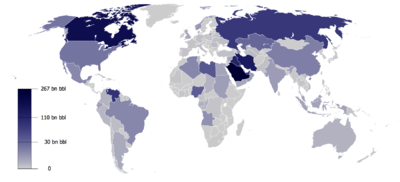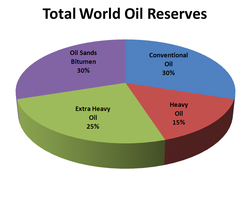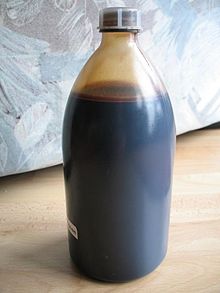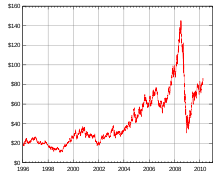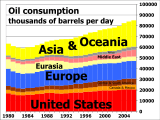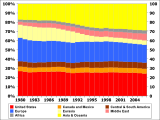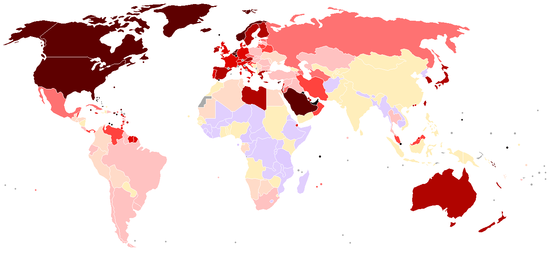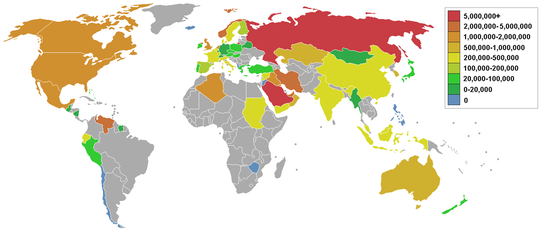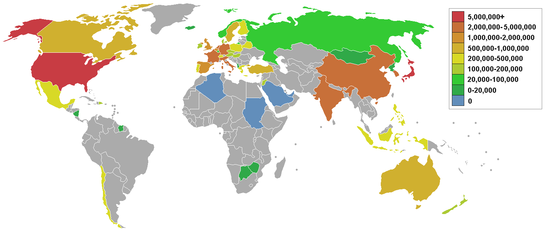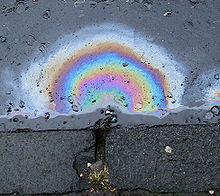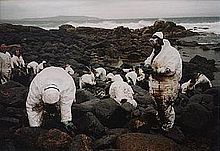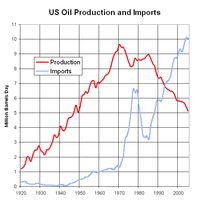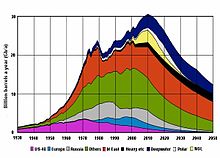- Petroleum
-
Petroleum (L. petroleum, from Greek: petra (rock) + Latin: oleum (oil)[1]) or crude oil is a naturally occurring, flammable liquid consisting of a complex mixture of hydrocarbons of various molecular weights and other liquid organic compounds, that are found in geologic formations beneath the Earth's surface. Petroleum is recovered mostly through oil drilling. This latter stage comes after the studies of structural geology (at the reservoir scale), sedimentary basin analysis, reservoir characterization (mainly in terms of porosity and permeable structures).[2][3] It is refined and separated, most easily by boiling point, into a large number of consumer products, from petrol and kerosene to asphalt and chemical reagents used to make plastics and pharmaceuticals.[4] Petroleum is used in manufacturing a wide variety of materials.[5]
Etymology
The term petroleum was found (in the spelling "petraoleum") in 10th-century Old English sources.[6] It was used in the treatise De Natura Fossilium, published in 1546 by the German mineralogist Georg Bauer, also known as Georgius Agricola.[7] In the 19th century, the term petroleum was frequently used to refer to mineral oils produced by distillation from mined organic solids such as cannel coal (and later oil shale), and refined oils produced from them; in the United Kingdom, storage (and later transport) of these oils were regulated by a series of Petroleum Acts, from the Petroleum Act 1862 c. 66 onward.
Composition
In its strictest sense, petroleum includes only crude oil, but in common usage it includes all liquid, gaseous, and solid (e.g., paraffin) hydrocarbons. Under surface pressure and temperature conditions, lighter hydrocarbons methane, ethane, propane and butane occur as gases, while pentane and heavier ones are in the form of liquids or solids. However, in an underground oil reservoir the proportions of gas, liquid, and solid depend on subsurface conditions and on the phase diagram of the petroleum mixture.[8]
An oil well produces predominantly crude oil, with some natural gas dissolved in it. Because the pressure is lower at the surface than underground, some of the gas will come out of solution and be recovered (or burned) as associated gas or solution gas. A gas well produces predominantly natural gas. However, because the underground temperature and pressure are higher than at the surface, the gas may contain heavier hydrocarbons such as pentane, hexane, and heptane in the gaseous state. At surface conditions these will condense out of the gas to form natural gas condensate, often shortened to condensate. Condensate resembles petrol in appearance and is similar in composition to some volatile light crude oils.
The proportion of light hydrocarbons in the petroleum mixture varies greatly among different oil fields, ranging from as much as 97% by weight in the lighter oils to as little as 50% in the heavier oils and bitumens.
The hydrocarbons in crude oil are mostly alkanes, cycloalkanes and various aromatic hydrocarbons while the other organic compounds contain nitrogen, oxygen and sulfur, and trace amounts of metals such as iron, nickel, copper and vanadium. The exact molecular composition varies widely from formation to formation but the proportion of chemical elements vary over fairly narrow limits as follows:[9]
Composition by weight Element Percent range Carbon 83 to 87% Hydrogen 10 to 14% Nitrogen 0.1 to 2% Oxygen 0.05 to 1.5% Sulfur 0.05 to 6.0% Metals < 0.1% Four different types of hydrocarbon molecules appear in crude oil. The relative percentage of each varies from oil to oil, determining the properties of each oil.[8]
Composition by weight Hydrocarbon Average Range Paraffins 30% 15 to 60% Naphthenes 49% 30 to 60% Aromatics 15% 3 to 30% Asphaltics 6% remainder Crude oil varies greatly in appearance depending on its composition. It is usually black or dark brown (although it may be yellowish, reddish, or even greenish). In the reservoir it is usually found in association with natural gas, which being lighter forms a gas cap over the petroleum, and saline water which, being heavier than most forms of crude oil, generally sinks beneath it. Crude oil may also be found in semi-solid form mixed with sand and water, as in the Athabasca oil sands in Canada, where it is usually referred to as crude bitumen. In Canada, bitumen is considered a sticky, black, tar-like form of crude oil which is so thick and heavy that it must be heated or diluted before it will flow.[11] Venezuela also has large amounts of oil in the Orinoco oil sands, although the hydrocarbons trapped in them are more fluid than in Canada and are usually called extra heavy oil. These oil sands resources are called unconventional oil to distinguish them from oil which can be extracted using traditional oil well methods. Between them, Canada and Venezuela contain an estimated 3.6 trillion barrels (570×109 m3) of bitumen and extra-heavy oil, about twice the volume of the world's reserves of conventional oil.[12]
Petroleum is used mostly, by volume, for producing fuel oil and petrol, both important "primary energy" sources.[13] 84% by volume of the hydrocarbons present in petroleum is converted into energy-rich fuels (petroleum-based fuels), including petrol, diesel, jet, heating, and other fuel oils, and liquefied petroleum gas.[14] The lighter grades of crude oil produce the best yields of these products, but as the world's reserves of light and medium oil are depleted, oil refineries are increasingly having to process heavy oil and bitumen, and use more complex and expensive methods to produce the products required. Because heavier crude oils have too much carbon and not enough hydrogen, these processes generally involve removing carbon from or adding hydrogen to the molecules, and using fluid catalytic cracking to convert the longer, more complex molecules in the oil to the shorter, simpler ones in the fuels.
Due to its high energy density, easy transportability and relative abundance, oil has become the world's most important source of energy since the mid-1950s. Petroleum is also the raw material for many chemical products, including pharmaceuticals, solvents, fertilizers, pesticides, and plastics; the 16% not used for energy production is converted into these other materials. Petroleum is found in porous rock formations in the upper strata of some areas of the Earth's crust. There is also petroleum in oil sands (tar sands). Known oil reserves are typically estimated at around 190 km3 (1.2 trillion (short scale) barrels) without oil sands,[15] or 595 km3 (3.74 trillion barrels) with oil sands.[16] Consumption is currently around 84 million barrels (13.4×106 m3) per day, or 4.9 km3 per year. Which in turn yields a remaining oil supply of only about 120 years, if current demand remain static.
Chemistry
 Octane, a hydrocarbon found in petroleum. Lines represent single bonds; black spheres represent carbon; white spheres represent hydrogen.
Octane, a hydrocarbon found in petroleum. Lines represent single bonds; black spheres represent carbon; white spheres represent hydrogen.
Petroleum is a mixture of a very large number of different hydrocarbons; the most commonly found molecules are alkanes (linear or branched), cycloalkanes, aromatic hydrocarbons, or more complicated chemicals like asphaltenes. Each petroleum variety has a unique mix of molecules, which define its physical and chemical properties, like color and viscosity.
The alkanes, also known as paraffins, are saturated hydrocarbons with straight or branched chains which contain only carbon and hydrogen and have the general formula CnH2n+2. They generally have from 5 to 40 carbon atoms per molecule, although trace amounts of shorter or longer molecules may be present in the mixture.
The alkanes from pentane (C5H12) to octane (C8H18) are refined into petrol, the ones from nonane (C9H20) to hexadecane (C16H34) into diesel fuel, kerosene and jet fuel). Alkanes with more than 16 carbon atoms can be refined into fuel oil and lubricating oil. At the heavier end of the range, paraffin wax is an alkane with approximately 25 carbon atoms, while asphalt has 35 and up, although these are usually cracked by modern refineries into more valuable products. The shortest molecules, those with four or fewer carbon atoms, are in a gaseous state at room temperature. They are the petroleum gases. Depending on demand and the cost of recovery, these gases are either flared off, sold as liquified petroleum gas under pressure, or used to power the refinery's own burners. During the winter, Butane (C4H10), is blended into the petrol pool at high rates, because butane's high vapor pressure assists with cold starts. Liquified under pressure slightly above atmospheric, it is best known for powering cigarette lighters, but it is also a main fuel source for many developing countries. Propane can be liquified under modest pressure, and is consumed for just about every application relying on petroleum for energy, from cooking to heating to transportation.
The cycloalkanes, also known as naphthenes, are saturated hydrocarbons which have one or more carbon rings to which hydrogen atoms are attached according to the formula CnH2n. Cycloalkanes have similar properties to alkanes but have higher boiling points.
The aromatic hydrocarbons are unsaturated hydrocarbons which have one or more planar six-carbon rings called benzene rings, to which hydrogen atoms are attached with the formula CnHn. They tend to burn with a sooty flame, and many have a sweet aroma. Some are carcinogenic.
These different molecules are separated by fractional distillation at an oil refinery to produce petrol, jet fuel, kerosene, and other hydrocarbons. For example, 2,2,4-Trimethylpentane (isooctane), widely used in petrol, has a chemical formula of C8H18 and it reacts with oxygen exothermically:[17]
- 2 C8H18(l) + 25 O2(g) → 16 CO2(g) + 18 H2O(g) + 10.86 MJ/mol (of octane)
The amount of various molecules in an oil sample can be determined in laboratory. The molecules are typically extracted in a solvent, then separated in a gas chromatograph, and finally determined with a suitable detector, such as a flame ionization detector or a mass spectrometer.[18] Due to the large number of co-eluted hydrocarbons within oil, many cannot be resolved by traditional gas chromatography and typically appear as a hump in the chromatogram. This unresolved complex mixture (UCM) of hydrocarbons is particularly apparent when analysing weathered oils and extracts from tissues of organisms exposed to oil.
Incomplete combustion of petroleum or petrol results in production of toxic byproducts. Too little oxygen results in carbon monoxide. Due to the high temperatures and high pressures involved, exhaust gases from petrol combustion in car engines usually include nitrogen oxides which are responsible for creation of photochemical smog.
Empirical equations for the thermal properties of petroleum products
Heat of combustion
At a constant volume the heat of combustion of a petroleum product can be approximated as follows:
- Qv = 12,400 − 2,100d2
where Qv is measured in cal/gram and d is the specific gravity at 60 °F (16 °C).
Thermal conductivity
The thermal conductivity of petroleum based liquids can be modeled as follows:
![K = \frac{0.813}{d}[1-0.0203(t-32)]](b/b3b3a0cfa1d3ebab0bd4764f133136e2.png) 0.547
0.547
where K is measured in BTU · hr−1ft−2 , t is measured in °F and d is the specific gravity at 60 °F (16 °C).
Specific heat
The specific heat of a petroleum oils can be modeled as follows:
![c = \frac{1}{\sqrt{d}} [0.388+0.00045t]](9/0e9ca0032f0e6d05b5d43bd37d87156e.png) ,
,
where c is measured in BTU/lbm-°F, t is the temperature in Fahrenheit and d is the specific gravity at 60 °F (16 °C).
In units of kcal/(kg·°C), the formula is:
![\frac{1}{\sqrt{d}} [0.402+0.00081t]](1/c415207d9ca864d8226f86157f2ff673.png) ,
,
where the temperature t is in Celsius and d is the specific gravity at 15 °C.
Latent heat of vaporization
The latent heat of vaporization can be modeled under atmospheric conditions as follows:
![L = \frac{1}{d}[110.9 - 0.09t]](8/d48ce3476cf3f07d3ddfbd920957e966.png) ,
,
where L is measured in BTU/lbm, t is measured in °F and d is the specific gravity at 60 °F (16 °C).
In units of kcal/kg, the formula is:
![L = \frac{1}{d}[194.4 - 0.162t]](a/aaa02f4901378661716a4658785bcdad.png) ,
,
where the temperature t is in Celsius and d is the specific gravity at 15 °C.[19]
Formation
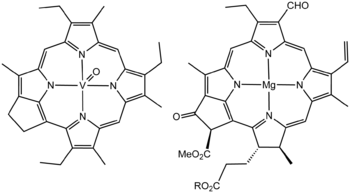 Structure of vanadium porphyrin compound extracted from petroleum by Alfred E. Treibs, father of organic geochemistry. Treibs noted the close structural similarity of this molecule and chlorophyll a.
Structure of vanadium porphyrin compound extracted from petroleum by Alfred E. Treibs, father of organic geochemistry. Treibs noted the close structural similarity of this molecule and chlorophyll a.
Petroleum is a fossil fuel derived from ancient fossilized organic materials, such as zooplankton and algae.[20] Vast quantities of these remains settled to sea or lake bottoms, mixing with sediments and being buried under anoxic conditions. As further layers settled to the sea or lake bed, intense heat and pressure built up in the lower regions. This process caused the organic matter to change, first into a waxy material known as kerogen, which is found in various oil shales around the world, and then with more heat into liquid and gaseous hydrocarbons via a process known as catagenesis. Formation of petroleum occurs from hydrocarbon pyrolysis in a variety of mainly endothermic reactions at high temperature and/or pressure.[21]
There were certain warm nutrient-rich environments such as the Gulf of Mexico and the ancient Tethys Sea where the large amounts of organic material falling to the ocean floor exceeded the rate at which it could decompose. This resulted in large masses of organic material being buried under subsequent deposits such as shale formed from mud. This massive organic deposit later became heated and transformed under pressure into oil.[22]
Geologists often refer to the temperature range in which oil forms as an "oil window"[23]—below the minimum temperature oil remains trapped in the form of kerogen, and above the maximum temperature the oil is converted to natural gas through the process of thermal cracking. Sometimes, oil formed at extreme depths may migrate and become trapped at a much shallower level. The Athabasca Oil Sands is one example of this.
Abiogenic origin hypothesis
A small number of geologists adhere to the abiogenic petroleum origin hypothesis, maintaining that high molecular weight hydrocarbons of purely inorganic origin exist within Earth's interior and are the source for major petroleum deposits. The hypothesis was originally proposed by Nikolai Kudryavtsev and Vladimir Porfiriev in the 1950s, and more recently Thomas Gold proposed a similar deep hot biosphere idea. The thermodynamic synthesis routes necessary to carry abiogenic source material into subsurface oil are not established, observation of organic markers in kerogen and oil is not explained, and no oil deposits have been located by this hypothesis.[24]
Crude oil
Crude oil reservoirs
Three conditions must be present for oil reservoirs to form: a source rock rich in hydrocarbon material buried deep enough for subterranean heat to cook it into oil; a porous and permeable reservoir rock for it to accumulate in; and a cap rock (seal) or other mechanism that prevents it from escaping to the surface. Within these reservoirs, fluids will typically organize themselves like a three-layer cake with a layer of water below the oil layer and a layer of gas above it, although the different layers vary in size between reservoirs. Because most hydrocarbons are lighter than rock or water, they often migrate upward through adjacent rock layers until either reaching the surface or becoming trapped within porous rocks (known as reservoirs) by impermeable rocks above. However, the process is influenced by underground water flows, causing oil to migrate hundreds of kilometres horizontally or even short distances downward before becoming trapped in a reservoir. When hydrocarbons are concentrated in a trap, an oil field forms, from which the liquid can be extracted by drilling and pumping.
The reactions that produce oil and natural gas are often modeled as first order breakdown reactions, where hydrocarbons are broken down to oil and natural gas by a set of parallel reactions, and oil eventually breaks down to natural gas by another set of reactions. The latter set is regularly used in petrochemical plants and oil refineries.
Wells are drilled into oil reservoirs to extract the crude oil. "Natural lift" production methods that rely on the natural reservoir pressure to force the oil to the surface are usually sufficient for a while after reservoirs are first tapped. In some reservoirs, such as in the Middle East, the natural pressure is sufficient over a long time. The natural pressure in many reservoirs, however, eventually dissipates. Then the oil must be pumped out using “artificial lift” created by mechanical pumps powered by gas or electricity. Over time, these "primary" methods become less effective and "secondary" production methods may be used. A common secondary method is “waterflood” or injection of water into the reservoir to increase pressure and force the oil to the drilled shaft or "wellbore." Eventually "tertiary" or "enhanced" oil recovery methods may be used to increase the oil's flow characteristics by injecting steam, carbon dioxide and other gases or chemicals into the reservoir. In the United States, primary production methods account for less than 40% of the oil produced on a daily basis, secondary methods account for about half, and tertiary recovery the remaining 10%. Extracting oil (or “bitumen”) from oil/tar sand and oil shale deposits requires mining the sand or shale and heating it in a vessel or retort, or using “in-situ” methods of injecting heated liquids into the deposit and then pumping out the oil-saturated liquid.
Unconventional oil reservoirs
Oil-eating bacteria biodegrade oil that has escaped to the surface. Oil sands are reservoirs of partially biodegraded oil still in the process of escaping and being biodegraded, but they contain so much migrating oil that, although most of it has escaped, vast amounts are still present—more than can be found in conventional oil reservoirs. The lighter fractions of the crude oil are destroyed first, resulting in reservoirs containing an extremely heavy form of crude oil, called crude bitumen in Canada, or extra-heavy crude oil in Venezuela. These two countries have the world's largest deposits of oil sands.
On the other hand, oil shales are source rocks that have not been exposed to heat or pressure long enough to convert their trapped hydrocarbons into crude oil. Technically speaking, oil shales are not always shales and do not contain oil, but are fined-grain sedimentary rocks containing an insoluble organic solid called kerogen. The kerogen in the rock can be converted into crude oil using heat and pressure to simulate natural processes. The method has been known for centuries and was patented in 1694 under British Crown Patent No. 330 covering, "A way to extract and make great quantities of pitch, tar, and oil out of a sort of stone." Although oil shales are found in many countries, the United States has the world's largest deposits.[25]
Classification
The petroleum industry generally classifies crude oil by the geographic location it is produced in (e.g. West Texas Intermediate, Brent, or Oman), its API gravity (an oil industry measure of density), and its sulfur content. Crude oil may be considered light if it has low density or heavy if it has high density; and it may be referred to as sweet if it contains relatively little sulfur or sour if it contains substantial amounts of sulfur.
The geographic location is important because it affects transportation costs to the refinery. Light crude oil is more desirable than heavy oil since it produces a higher yield of petrol, while sweet oil commands a higher price than sour oil because it has fewer environmental problems and requires less refining to meet sulfur standards imposed on fuels in consuming countries. Each crude oil has unique molecular characteristics which are understood by the use of crude oil assay analysis in petroleum laboratories.
Barrels from an area in which the crude oil's molecular characteristics have been determined and the oil has been classified are used as pricing references throughout the world. Some of the common reference crudes are:
- West Texas Intermediate (WTI), a very high-quality, sweet, light oil delivered at Cushing, Oklahoma for North American oil
- Brent Blend, comprising 15 oils from fields in the Brent and Ninian systems in the East Shetland Basin of the North Sea. The oil is landed at Sullom Voe terminal in Shetland. Oil production from Europe, Africa and Middle Eastern oil flowing West tends to be priced off this oil, which forms a benchmark
- Dubai-Oman, used as benchmark for Middle East sour crude oil flowing to the Asia-Pacific region
- Tapis (from Malaysia, used as a reference for light Far East oil)
- Minas (from Indonesia, used as a reference for heavy Far East oil)
- The OPEC Reference Basket, a weighted average of oil blends from various OPEC (The Organization of the Petroleum Exporting Countries) countries
- Midway Sunset Heavy, by which heavy oil in California is priced [26]
There are declining amounts of these benchmark oils being produced each year, so other oils are more commonly what is actually delivered. While the reference price may be for West Texas Intermediate delivered at Cushing, the actual oil being traded may be a discounted Canadian heavy oil delivered at Hardisty, Alberta, and for a Brent Blend delivered at Shetland, it may be a Russian Export Blend delivered at the port of Primorsk.[27]
Petroleum industry
The petroleum industry is involved in the global processes of exploration, extraction, refining, transporting (often with oil tankers and pipelines), and marketing petroleum products. The largest volume products of the industry are fuel oil and petrol . Petroleum is also the raw material for many chemical products, including pharmaceuticals, solvents, fertilizers, pesticides, and plastics. The industry is usually divided into three major components: upstream, midstream and downstream. Midstream operations are usually included in the downstream category.
Petroleum is vital to many industries, and is of importance to the maintenance of industrialized civilization itself, and thus is critical concern to many nations. Oil accounts for a large percentage of the world's energy consumption, ranging from a low of 32% for Europe and Asia, up to a high of 53% for the Middle East. Other geographic regions' consumption patterns are as follows: South and Central America (44%), Africa (41%), and North America (40%). The world at large consumes 30 billion barrels (4.8 km³) of oil per year, and the top oil consumers largely consist of developed nations. In fact, 24% of the oil consumed in 2004 went to the United States alone,[28] though by 2007 this had dropped to 21% of world oil consumed.[29]
In the US, in the states of Arizona, California, Hawaii, Nevada, Oregon and Washington, the Western States Petroleum Association (WSPA) represents companies responsible for producing, distributing, refining, transporting and marketing petroleum. This non-profit trade association was founded in 1907, and is the oldest petroleum trade association in the United States.[30]
History
Main article: History of petroleumPetroleum, in one form or another, has been used since ancient times, and is now important across society, including in economy, politics and technology. The rise in importance was mostly due to the invention of the internal combustion engine, the rise in commercial aviation and the increasing use of plastic.
More than 4000 years ago, according to Herodotus and Diodorus Siculus, asphalt was used in the construction of the walls and towers of Babylon; there were oil pits near Ardericca (near Babylon), and a pitch spring on Zacynthus.[31] Great quantities of it were found on the banks of the river Issus, one of the tributaries of the Euphrates. Ancient Persian tablets indicate the medicinal and lighting uses of petroleum in the upper levels of their society. By 347 AD, oil was produced from bamboo-drilled wells in China.[32]
In the 1850s, the process to distill kerosene from petroleum was invented by Ignacy Łukasiewicz, providing a cheaper alternative to whale oil. The demand for the petroleum as a fuel for lighting in North America and around the world quickly grew.[33] The world's first commercial oil well was drilled in Poland in 1853. Oil exploration developed in many parts of the world with the Russian Empire, particularly the Branobel company in Azerbaijan (Asia's first modern borehole oil production began in 1848 at the Bibi-Heybat field near Baku), taking the lead in production by the end of the 19th century.[34][verification needed]
Access to oil was and still is a major factor in several military conflicts of the twentieth century, including World War II, during which oil facilities were a major strategic asset and were extensively bombed.[35] Operation Barbarossa included the goal to capture the Baku oilfields, as it would provide much needed oil-supplies for the German military which was suffering from blockades.[36] Oil exploration in North America during the early 20th century later led to the U.S. becoming the leading producer by the mid 1900s. As petroleum production in the U.S. peaked during the 1960s, however, the United States was surpassed by Saudi Arabia and Russia.
Today, about 90% of vehicular fuel needs are met by oil. Petroleum also makes up 40% of total energy consumption in the United States, but is responsible for only 1% of electricity generation. Petroleum's worth as a portable, dense energy source powering the vast majority of vehicles and as the base of many industrial chemicals makes it one of the world's most important commodities. Viability of the oil commodity is controlled by several key parameters, number of vehicles in the world competing for fuel, quantity of oil exported to the world market (Export Land Model), Net Energy Gain (economically useful energy provided minus energy consumed), political stability of oil exporting nations and ability to defend oil supply lines.
The top three oil producing countries are Saudi Arabia, Russia, and the United States.[37] About 80% of the world's readily accessible reserves are located in the Middle East, with 62.5% coming from the Arab 5: Saudi Arabia, UAE, Iraq, Qatar and Kuwait. A large portion of the world's total oil exists as unconventional sources, such as bitumen in Canada and Venezuela and oil shale. While significant volumes of oil are extracted from oil sands, particularly in Canada, logistical and technical hurdles remain, as oil extraction requires large amounts of heat and water, making its net energy content quite low relative to conventional crude oil. Thus, Canada's oil sands are not expected to provide more than a few million barrels per day in the foreseeable future.
Conventional crude oil production, those having Net Energy Gain above 10 stopped growing in 2005 at about 74 million barrels per day (11,800,000 m3/d). The International Energy Agency's (IEA) 2010 World Energy Outlook estimated that conventional crude oil production has peaked and is depleting at 6.8% per year. US Joint Forces Command's Joint Operating Environment 2010 issued this warning to all US military commands "By 2012, surplus oil production capacity could entirely disappear, and as early as 2015, the shortfall in output could reach nearly 10 million barrels per day."
Price
After the collapse of the OPEC-administered pricing system in 1985, and a short lived experiment with netback pricing, oil-exporting countries adopted a market-linked pricing mechanism.[38] First adopted by PEMEX in 1986, market-linked pricing was widely accepted, and by 1988 became and still is the main method for pricing crude oil in international trade.[38] The current reference, or pricing markers, are Brent, WTI, and Dubai/Oman.[38]
Uses
Further information: Petroleum productsThe chemical structure of petroleum is heterogeneous, composed of hydrocarbon chains of different lengths. Because of this, petroleum may be taken to oil refineries and the hydrocarbon chemicals separated by distillation and treated by other chemical processes, to be used for a variety of purposes. See Petroleum products.
Fuels
The most common distillation fractions of petroleum are fuels. Fuels include (by increasing boiling temperature range):[39]
Common fractions of petroleum as fuels Fraction Boiling Range oC Liquefied petroleum gas (LPG) -40 Butane -12 to -1 Petrol -1 to 180 Jet fuel 150 to 205 Kerosene 205 to 260 Fuel oil 205 to 290 Diesel fuel 260 to 315 Other derivatives
Certain types of resultant hydrocarbons may be mixed with other non-hydrocarbons, to create other end products:
- Alkenes (olefins) which can be manufactured into plastics or other compounds
- Lubricants (produces light machine oils, motor oils, and greases, adding viscosity stabilizers as required).
- Wax, used in the packaging of frozen foods, among others.
- Sulfur or Sulfuric acid. These are a useful industrial materials. Sulfuric acid is usually prepared as the acid precursor oleum, a byproduct of sulfur removal from fuels.
- Bulk tar.
- Asphalt
- Petroleum coke, used in speciality carbon products or as solid fuel.
- Paraffin wax
- Aromatic petrochemicals to be used as precursors in other chemical production.
Agriculture
Since the 1940s, agricultural productivity has increased dramatically, due largely to the increased use of energy-intensive mechanization, fertilizers and pesticides. Nearly all pesticides and many fertilizers are made from oil.[40]
Petroleum by country
Consumption statistics
Consumption
According to the CIA World Factbook estimate for 2010 the world consumes about 87 million barrels of oil each day.
This table orders the amount of petroleum consumed in 2008 in thousand barrels (bbl) per day and in thousand cubic metres (m3) per day:[41][42][43]
Consuming Nation 2008 (1000 bbl/day) (1000 m3/day) population in millions bbl/year per capita m3/year per capita United States 1 19,497.95 3,099.9 314 22.6 3.59 China 7,831.00 1,245.0 1345 2.1 0.33 Japan 2 4,784.85 760.7 127 13.7 2.18 India 2 2,962.00 470.9 1198 0.9 0.14 Russia 1 2,916.00 463.6 140 7.6 1.21 Germany 2 2,569.28 408.5 82 11.4 1.81 Brazil 2,485.00 395.1 193 4.7 0.75 Saudi Arabia (OPEC) 2,376.00 377.8 25 33.7 5.36 Canada 2,261.36 359.5 33 24.6 3.91 South Korea 2 2,174.91 345.8 48 16.4 2.61 Mexico 1 2,128.46 338.4 109 7.1 1.13 France 2 1,986.26 315.8 62 11.6 1.84 Iran (OPEC) 1,741.00 276.8 74 8.6 1.37 United Kingdom 1 1,709.66 271.8 61 10.1 1.61 Italy 2 1,639.01 260.6 60 10 1.6 Source: US Energy Information Administration
Population Data:[44]
1 peak production of oil already passed in this state
2 This country is not a major oil producer
Production
In petroleum industry parlance, production refers to the quantity of crude extracted from reserves, not the literal creation of the product.
# Producing Nation 103bbl/d (2006) 103bbl/d (2007) 103bbl/d (2008) 103bbl/d (2009) Present Share 1 Saudi Arabia (OPEC) 10,665 10,234 10,782 9,760 11.8% 2 Canada 2 3,288 3,358 3,350 3,294 4.0% 3 Russia 1 9,677 9,876 9,789 9,934 12.0% 4 United States 1 8,331 8,481 8,514 9,141 11.1% 5 Iran (OPEC) 4,148 4,043 4,174 4,177 5.1% 6 China 3,846 3,901 3,973 3,996 4.8% 7 Canada 2 3,288 3,358 3,350 3,294 4.0% 8 Mexico 1 3,707 3,501 3,185 3,001 3.6% 9 United Arab Emirates (OPEC) 2,945 2,948 3,046 2,795 3.4% 10 Kuwait (OPEC) 2,675 2,613 2,742 2,496 3.0% 11 Venezuela (OPEC) 1 2,803 2,667 2,643 2,471 3.0% 12 Norway 1 2,786 2,565 2,466 2,350 2.8% 13 Brazil 2,166 2,279 2,401 2,577 3.1% 14 Iraq (OPEC) 3 2,008 2,094 2,385 2,400 2.9% 15 Algeria (OPEC) 2,122 2,173 2,179 2,126 2.6% 16 Nigeria (OPEC) 2,443 2,352 2,169 2,211 2.7% 17 Angola (OPEC) 1,435 1,769 2,014 1,948 2.4% 18 Libya (OPEC) 1,809 1,845 1,875 1,789 2.2% 19 United Kingdom 1,689 1,690 1,584 1,422 1.7% 20 Kazakhstan 1,388 1,445 1,429 1,540 1.9% 21 Qatar (OPEC) 1,141 1,136 1,207 1,213 1.5% 22 Indonesia 1,102 1,044 1,051 1,023 1.2% 23 India 854 881 884 877 1.1% 24 Azerbaijan 648 850 875 1,012 1.2% 25 Argentina 802 791 792 794 1.0% 26 Oman 743 714 761 816 1.0% 27 Malaysia 729 703 727 693 0.8% 28 Egypt 667 664 631 678 0.8% 29 Colombia 544 543 601 686 0.8% 30 Australia 552 595 586 588 0.7% 31 Ecuador (OPEC) 536 512 505 485 0.6% 32 Sudan 380 466 480 486 0.6% 33 Syria 449 446 426 400 0.5% 34 Equatorial Guinea 386 400 359 346 0.4% 35 Thailand 334 349 361 339 0.4% 36 Vietnam 362 352 314 346 0.4% 37 Yemen 377 361 300 287 0.3% 38 Denmark 344 314 289 262 0.3% 39 Gabon 237 244 248 242 0.3% 40 South Africa 204 199 195 192 0.2% 41 Turkmenistan No data 180 189 198 0.2% Source: U.S. Energy Information Administration
1 Peak production of conventional oil already passed in this state
2 Although Canadian conventional oil production is declining, total oil production is increasing as oil sands production grows. If oil sands are included, it has the world's second largest oil reserves after Saudi Arabia.
3 Though still a member, Iraq has not been included in production figures since 1998
Export
See also: Fossil fuel exporters and Organization of Petroleum Exporting CountriesIn order of net exports in 2009 and 2006 in thousand bbl/d and thousand m³/d:
# Exporting Nation 103bbl/d (2009) 103m3/d (2009) 103bbl/d (2006) 103m3/d (2006) 1 Saudi Arabia (OPEC) 7,322 1,164 8,651 1,376 2 Russia 1 7,194 1,144 6,565 1,044 3 Iran (OPEC) 2,486 395 2,519 401 4 United Arab Emirates (OPEC) 2,303 366 2,515 400 5 Norway 1 2,132 339 2,542 404 6 Kuwait (OPEC) 2,124 338 2,150 342 7 Nigeria (OPEC) 1,939 308 2,146 341 8 Angola (OPEC) 1,878 299 1,363 217 9 Algeria (OPEC) 1 1,767 281 1,847 297 10 Iraq (OPEC) 1,764 280 1,438 229 11 Venezuela (OPEC) 1 1,748 278 2,203 350 12 Libya (OPEC) 1 1,525 242 1,525 242 13 Kazakhstan 1,299 207 1,114 177 14 Canada 2 1,168 187 1,071 170 15 Qatar (OPEC) 1,066 169 - - - Mexico 1 1,039 165 1,676 266 Source: US Energy Information Administration
1 peak production already passed in this state
2 Canadian statistics are complicated by the fact it is both an importer and exporter of crude oil, and refines large amounts of oil for the U.S. market. It is the leading source of U.S. imports of oil and products, averaging 2,500,000 bbl/d (400,000 m3/d) in August 2007. [2].
Total world production/consumption (as of 2005) is approximately 84 million barrels per day (13,400,000 m3/d).
Import
In order of net imports in 2009 and 2006 in thousand bbl/d and thousand m³/d:
# Importing Nation 103bbl/day (2009) 103m3/day (2009) 103bbl/day (2006) 103m3/day (2006) 1 United States 1 9,631 1,531 12,220 1,943 2 China 2 4,328 688 3,438 547 3 Japan 4,235 673 5,097 810 4 Germany 2,323 369 2,483 395 5 India 2,233 355 1,687 268 6 South Korea 2,139 340 2,150 342 7 France 1,749 278 1,893 301 8 United Kingdom 1,588 252 - - 9 Spain 1,439 229 1,555 247 10 Italy 1,381 220 1,558 248 11 Netherlands 973 155 936 149 12 Republic of China (Taiwan) 944 150 942 150 13 Singapore 916 146 787 125 14 Turkey 650 103 576 92 15 Belgium 597 95 546 87 - Thailand 538 86 606 96 Source: US Energy Information Administration
1 peak production of oil already passed in this state[citation needed]
2 Major oil producer whose production is still increasing[citation needed]
Non-producing consumers
Countries whose oil production is 10% or less of their consumption.
# Consuming Nation (bbl/day) (m³/day) 1 Japan 5,578,000 886,831 2 Germany 2,677,000 425,609 3 South Korea 2,061,000 327,673 4 France 2,060,000 327,514 5 Italy 1,874,000 297,942 6 Spain 1,537,000 244,363 7 Netherlands 946,700 150,513 8 Turkey 575,011 91,663 Source: CIA World Factbook[not in citation given]
Environmental effects
Main article: Environmental issues with petroleumBecause petroleum is a naturally occurring substance, its presence in the environment need not be the result of human causes such as accidents and routine activities ( seismic exploration, drilling, extraction, refining and combustion). Phenomena such as seeps[46] and tar pits are examples of areas that petroleum naturally affects. Regardless of source, petroleum's effects when released into the environment are similar.
Global warming
When burned, petroleum releases carbon dioxide; a greenhouse gas. Along with the burning of coal, petroleum combustion is the largest contributor to the increase in atmospheric CO2. Atmospheric CO2 has risen steadily since the industrial revolution to current levels of over 380ppmv, from the 180 - 300ppmv of the prior 800 thousand years, driving global warming.[47][48][49]
Extraction
Oil extraction is simply the removal of oil from the reservoir (oil pool). Oil is often recovered as a water-in-oil emulsion, and specialty chemicals called demulsifiers are used to separate the oil from water. Oil extraction is costly and sometimes environmentally damaging, although Dr. John Hunt of the Woods Hole Oceanographic Institution pointed out in a 1981 paper that over 70% of the reserves in the world are associated with visible macroseepages, and many oil fields are found due to natural seeps. Offshore exploration and extraction of oil disturbs the surrounding marine environment.[50]
Oil spills
Crude oil and refined fuel spills from tanker ship accidents have damaged natural ecosystems in Alaska, the Gulf of Mexico, the Galapagos Islands, France and many other places.
The quantity of oil spilled during accidents has ranged from a few hundred tons to several hundred thousand tons (e.g., Deepwater Horizon Oil Spill, Atlantic Empress, Amoco Cadiz). Smaller spills have already proven to have a great impact on ecosystems, such as the Exxon Valdez oil spill
Oil spills at sea are generally much more damaging than those on land, since they can spread for hundreds of nautical miles in a thin oil slick which can cover beaches with a thin coating of oil. This can kill sea birds, mammals, shellfish and other organisms it coats. Oil spills on land are more readily containable if a makeshift earth dam can be rapidly bulldozed around the spill site before most of the oil escapes, and land animals can avoid the oil more easily.
Control of oil spills is difficult, requires ad hoc methods, and often a large amount of manpower. The dropping of bombs and incendiary devices from aircraft on the Torrey Canyon wreck produced poor results;[51] modern techniques would include pumping the oil from the wreck, like in the Prestige oil spill or the Erika oil spill.[52]
Though crude oil is predominantly composed of various hydrocarbons, certain nitrogen heterocylic compounds, such as pyridine, picoline, and quinoline are reported as contaminants associated with crude oil, as well as facilities processing oil shale or coal, and have also been found at legacy wood treatment sites. These compounds have a very high water solubility, and thus tend to dissolve and move with water. Certain naturally occurring bacteria, such as Micrococcus, Arthrobacter, and Rhodococcus and have been shown to degrade these contaminants.[53]
Degradation of underground tanks located at gas stations may also occur, significantly affecting soil and groundwater. In these instances of the biological degradation of petroleum hydrocarbons, solutions such as bioremediation may be used.[citation needed]
Tarballs
A tarball is a blob of oil (not to be confused with tar, which is typically derived from pine trees rather than petroleum) which has been weathered after floating in the ocean. Tarballs are an aquatic pollutant in most environments, although they can occur naturally, for example, in the Santa Barbara Channel of California.[54][55] Their concentration and features have been used to assess the extent of oil spills. Their composition can be used to identify their sources of origin,[56][57] and tarballs themselves may be dispersed over long distances by deep sea currents.[55] They are slowly decomposed by bacteria, including Chromobacterium violaceum, Cladosporium resinae, Bacillus submarinus, Micrococcus varians, Pseudomonas aeruginosa, Candida marina and Saccharomyces estuari.[54]
Whales
James S. Robbins has argued that the advent of petroleum-refined kerosene saved some species of great whales from extinction by providing an inexpensive substitute for whale oil, thus eliminating the economic imperative for open-boat whaling.[58]
Alternatives to petroleum
In the United States in 2007 about 70% of petroleum was used for transportation (e.g. petrol, diesel, jet fuel), 24% by industry (e.g. production of plastics), 5% for residential and commercial uses, and 2% for electricity production.[59] Outside of the US, a higher proportion of petroleum tends to be used for electricity.[60]
Alternatives to petroleum-based vehicle fuels
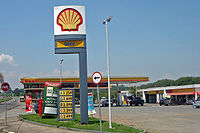 Typical Brazilian fuel station with four alternative fuels for sale: diesel (B3), gasohol (E25), neat ethanol (E100), and compressed natural gas (CNG).
Typical Brazilian fuel station with four alternative fuels for sale: diesel (B3), gasohol (E25), neat ethanol (E100), and compressed natural gas (CNG).
Alternative fuel vehicles refers to both:
- vehicles that use alternative fuels used in standard or modified internal combustion engines such as natural gas vehicles, neat ethanol vehicles, flexible-fuel vehicles, biodiesel-powered vehicles, and hydrogen vehicles.
- vehicles with advanced propulsion systems that reduce or substitute petroleum use such as battery electric vehicles, plug-in hybrid electric vehicles, hybrid electric vehicles, and hydrogen fuel cell vehicles.
Alternatives to using oil in industry
Biological feedstocks do exist for industrial uses such as Bioplastic production.[61]
Alternatives to burning petroleum for electricity
In oil producing countries with little refinery capacity, oil is sometimes burned to produce electricity. Renewable energy technologies such as solar power, wind power, micro hydro, biomass and biofuels might someday be used to replace some of these generators, but today the primary alternatives remain large scale hydroelectricity, nuclear and coal-fired generation.
Future of petroleum production
Consumption in the twentieth and twenty-first centuries has been abundantly pushed by automobile growth; the 1985-2003 oil glut even fuelled the sales of low economy vehicles in OECD countries. In 2008, the economic crisis seems to have some impact on the sales of such vehicles; still, the 2008 oil consumption shows a small increase. The BRIC countries might also kick in, as China briefly was the first automobile market in December 2009.[62] The immediate outlook still hints upwards. In the long term, uncertainties linger; the OPEC believes that the OECD countries will push low consumption policies at some point in the future; when that happens, it will definitely curb the oil sales, and both OPEC and EIA kept lowering their 2020 consumption estimates during the past 5 years.[63] Oil products are more and more in competition with alternative sources, mainly coal and natural gas, both cheaper sources.
Production will also face an increasingly complex situation; while OPEC countries still have large reserves at low production prices, newly found reservoirs often lead to higher prices; offshore giants such as Tupi, Guara and Tiber demand high investments and ever-increasing technological abilities. Subsalt reservoirs such as Tupi were unknown in the twentieth century, mainly because the industry was unable to probe them. Enhanced Oil Recovery (EOR) techniques (example: DaQing, China [64] ) will continue to play a major role in increasing the world's recoverable oil.
Hubbert peak theory
The Hubbert peak theory (also known as peak oil) posits that future petroleum production (whether for individual oil wells, entire oil fields, whole countries, or worldwide production) will eventually peak and then decline at a similar rate to the rate of increase before the peak as these reserves are exhausted. The peak of oil discoveries was in 1965, and oil production per year has surpassed oil discoveries every year since 1980.[65]
Hubbert applied his theory to predict the peak of U.S. oil production at a date between 1966 and 1970. This prediction was based on data available at the time of his publication in 1956. In the same paper, Hubbert predicts world peak oil in "half a century" after his publication, which would be 2006.[66]
It is difficult to predict the oil peak in any given region, due to the lack of knowledge and/or transparency in accounting of global oil reserves.[67] The scientist and researchers from Oxford University argue that official figures are inflated because OPEC members over-reported reserves in the 1980s when competing for global market share.[68] Based on available production data, proponents have previously predicted the peak for the world to be in years 1989, 1995, or 1995-2000. Some of these predictions date from before the recession of the early 1980s, and the consequent reduction in global consumption, the effect of which was to delay the date of any peak by several years. Just as the 1971 U.S. peak in oil production was only clearly recognized after the fact, a peak in world production will be difficult to discern until production clearly drops off.[original research?]
The International Energy Agency (IEA) says production of conventional crude oil peaked in 2006.[69][70] Since virtually all economic sectors rely heavily on petroleum, peak oil could lead to a "partial or complete failure of markets."[71]
See also
- Barrel of oil equivalent
- Gas oil ratio
- Gross domestic product per barrel
- List of countries by proven oil reserves
- List of oil fields
- List of petroleum companies
- Manure-derived synthetic crude oil
- Oil burden
- Petroleum geology
- Thermal depolymerization
- Waste oil
- Tar Sands
Notes
- ^ "Petroleum". Concise Oxford English Dictionary
- ^ Guerriero V. et al. (2011). "Improved statistical multi-scale analysis of fractures in carbonate reservoir analogues". Tectonophysics (Elsevier) 504: 14–24. doi:10.1016/j.tecto.2011.01.003.
- ^ Guerriero V. et al. (2010). "Quantifying uncertainties in multi-scale studies of fractured reservoir analogues: Implemented statistical analysis of scan line data from carbonate rocks". Journal of Structural Geology (Elsevier) 32 (9): 1271–1278. doi:10.1016/j.jsg.2009.04.016.
- ^ "Organic Hydrocarbons: Compounds made from carbon and hydrogen". Archived from the original on 2011-07-19. http://web.archive.org/web/20110719184614/http://cactus.dixie.edu/smblack/chem1010/lecture_notes/2B.htm.
- ^ "Libyan tremors threaten to rattle the oil world". The Hindu (Chennai, India). 2011-03-01. http://www.hindu.com/2011/03/01/stories/2011030155921100.htm.
- ^ Oxford English Dictionary online edition, entry "petroleum"
- ^ Bauer (1546)
- ^ a b Hyne (2001), pp. 1–4.
- ^ Speight (1999), p. 215–216.
- ^ Alboudwarej et al. (Summer 2006) (PDF). Highlighting Heavy Oil. Oilfield Review. http://www.slb.com/media/services/resources/oilfieldreview/ors06/sum06/heavy_oil.pdf. Retrieved 2008-05-24.
- ^ "Oil Sands – Glossary". Mines and Minerals Act. Government of Alberta. 2007. Archived from the original on 2007-11-01. http://web.archive.org/web/20071101112113/http://www.energy.gov.ab.ca/OilSands/1106.asp. Retrieved 2008-10-02.
- ^ "Oil Sands in Canada and Venezuela". Infomine Inc.. 2008. http://oilsands.infomine.com/countries/. Retrieved 2008-10-02.
- ^ IEA Key World Energy Statistics[dead link]
- ^ "Crude oil is made into different fuels". Eia.doe.gov. http://www.eia.doe.gov/kids/energyfacts/sources/non-renewable/oil.html#Howused. Retrieved 2010-08-29.
- ^ "EIA reserves estimates". Eia.doe.gov. http://www.eia.doe.gov/emeu/international/reserves.html. Retrieved 2010-08-29.
- ^ "CERA report on total world oil". Cera.com. 2006-11-14. http://www.cera.com/aspx/cda/public1/news/pressReleases/pressReleaseDetails.aspx?CID=8444. Retrieved 2010-08-29.
- ^ "Heat of Combustion of Fuels". Webmo.net. http://www.webmo.net/curriculum/heat_of_combustion/heat_of_combustion_key.html. Retrieved 2010-08-29.
- ^ Use of ozone depleting substances in laboratories. TemaNord 2003:516.
- ^ United States Bureau of Standards, "Thermal Properties of Petroleum Products". Miscellaneous Publication No. 97, November 9th, 1929.
- ^ Kvenvolden, Keith A. (2006). "Organic geochemistry – A retrospective of its first 70 years". Organic Geochemistry 37: 1. doi:10.1016/j.orggeochem.2005.09.001.
- ^ Braun, Robert L.; Burnham, lan K. (June 1993). "Chemical Reaction Model for Oil and Gas Generation from Type I and Type II Kerogen". Lawrence Livermore National Laboratory. http://www.osti.gov/bridge/servlets/purl/10169154-cT5xip/10169154.PDF. Retrieved 2010-08-29.
- ^ Broad, William J. (August 2, 2010). "Tracing Oil Reserves to Their Tiny Origins". The New York Times. http://www.nytimes.com/2010/08/03/science/03oil.html. Retrieved August 2, 2010.
- ^ Polar Prospects:A minerals treaty for Antarctica. United States, Office of Technology Assessment. September 1989. p. 104. ISBN 9781428922327. http://books.google.com/?id=xwLHnC9qMsgC&pg=PA104&dq=%22oil+window%22+geology#v=onepage&q=%22oil%20window%22%20geology&f=false.
- ^ Glasby, Geoffrey P. (2006). "Abiogenic origin of hydrocarbons: an historical overview" (PDF). Resource Geology 56 (1): 83–96. doi:10.1111/j.1751-3928.2006.tb00271.x. http://static.scribd.com/docs/j79lhbgbjbqrb.pdf. Retrieved 2008-02-17.
- ^ Lambertson, Giles (2008-02-16). "Oil Shale: Ready to Unlock the Rock". Construction Equipment Guide. http://www.cegltd.com/story.asp?story=10092. Retrieved 2008-05-21.
- ^ "Chevron Crude Oil Marketing - North America Posted Pricing - California". Crudemarketing.chevron.com. 2007-05-01. http://crudemarketing.chevron.com/posted_pricing_daily_california.asp. Retrieved 2010-08-29.
- ^ "Light Sweet Crude Oil". About the Exchange. New York Mercantile Exchange (NYMEX). 2006. Archived from the original on 2008-03-14. http://web.archive.org/web/20080314074204/http://www.nymex.com/lsco_fut_descri.aspx. Retrieved 2008-04-21.
- ^ "International Energy Annual 2004" (XLS). Energy Information Administration. 2006-07-14. http://www.eia.doe.gov/pub/international/iealf/tablee2.xls.
- ^ "Yearbook 2008 - crude oil". Energy data. http://yearbook.enerdata.net.
- ^ "Western States Petroleum Association - About Us". Archived from the original on June 16, 2008. http://web.archive.org/web/20080616140609/http://www.wspa.org/about/index.htm. Retrieved 2008-11-03.
- ^
 This article incorporates text from a publication now in the public domain: Chisholm, Hugh, ed (1911). "Petroleum". Encyclopædia Britannica (11th ed.). Cambridge University Press.
This article incorporates text from a publication now in the public domain: Chisholm, Hugh, ed (1911). "Petroleum". Encyclopædia Britannica (11th ed.). Cambridge University Press. - ^ George E. Totten ASTM Timeline
- ^ Maugeri (2006), p. 3
- ^ Akiner(2004), p. 5
- ^ Hanson Baldwin, 1959, “Oil Strategy in World War II", American Petroleum Institute Quarterly – Centennial Issue, pages 10-11. American Petroleum Institute.
- ^ Baku: City that Oil Built Archived 11 February 2011 at WebCite
- ^ "InfoPlease". InfoPlease. http://www.infoplease.com/ipa/A0922041.html. Retrieved 2010-08-29.
- ^ a b c Mabro (2006), p. 351.
- ^ Speight (1999), p. 543.
- ^ "World oil supplies are set to run out faster than expected, warn scientists". The Independent. June 14, 2007.
- ^ U.S. Energy Information Administration. Excel file from this web page. Table Posted: March 1, 2010
- ^ From DSW-Datareport 2008 ("Deutsche Stiftung Weltbevölkerung")
- ^ One cubic metre of oil is equivalent to 6.28981077 barrels of oil
- ^ "IBGE". IBGE. http://www.ibge.gov.br/paisesat/main.php. Retrieved 2010-08-29.
- ^ "World Crude Oil Production" (PDF). http://www.eia.doe.gov/emeu/aer/pdf/pages/sec11_10.pdf. Retrieved 2010-08-29.
- ^ http://seeps.wr.usgs.gov/ Natural Oil and Gas Seeps in California
- ^ Historical trends in carbon dioxide concentrations and temperature, on a geological and recent time scale. (June 2007). In UNEP/GRID-Arendal Maps and Graphics Library. Retrieved 19:14, February 19, 2011.
- ^ Deep ice tells long climate story. Retrieved 19:14, February 19, 2011.
- ^ Mitchell, John F. B. (1989). "THE "GREENHOUSE" EFFECT AND CLIMATE CHANGE". Reviews of Geophysics (American Geophysical Union) 27 (1): 115–139. doi:10.1029/RG027i001p00115. http://astrosun2.astro.cornell.edu/academics/courses/astro202/Mitchell_GRL89.pdf. Retrieved February 19, 2011.
- ^ Waste discharges during the offshore oil and gas activity by Stanislave Patin, tr. Elena Cascio
- ^ Torrey Canyon bombing by the Navy and RAF
- ^ "Pumping of the Erika cargo". Total.com. http://www.total.com/en/group/news/special_report_erika/erika_measures_total/erika_pumping_cargo_11379.htm. Retrieved 2010-08-29.
- ^ Sims, G. K. and E.J. O'Loughlin. 1989. Degradation of pyridines in the environment. CRC Critical Reviews in Environmental Control. 19(4): 309-340.
- ^ a b A. Y. Itah and J. P. Essien, Growth Profile and Hydrocarbonoclastic Potential of Microorganisms Isolated from Tarballs in the Bight of Bonny, Nigeria, World Journal of Microbiology and Biotechnology, Volume 21, Numbers 6-7, October, 2005, doi:10.1007/s11274-004-6694-z, p 1317-1322
- ^ a b Frances D. Hostettler, Robert J. Rosenbauer, Thomas D. Lorenson, Jennifer Dougherty, Geochemical characterization of tarballs on beaches along the California coast. Part I-- Shallow seepage impacting the Santa Barbara Channel Islands, Santa Cruz, Santa Rosa and San Miguel, Organic Geochemistry, Volume 35, Issue 6, June 2004, Pages 725-746, ISSN 0146-6380, doi:10.1016/j.orggeochem.2004.01.022. [1]
- ^ Anthony H Knap, Kathryn A Burns, Rodger Dawson, Manfred Ehrhardt and Karsten H Palmork, Dissolved/dispersed hydrocarbons, tarballs and the surface microlayer: Experiences from an IOC/UNEP Workshop in Bermuda, December, 1984, Marine Pollution Bulletin, Volume 17, Issue 7, July 1986, Pages 313-319. doi:10.1016/0025-326X(86)90217-1
- ^ Zhendi Wang, Merv Fingas, Michael Landriault, Lise Sigouin, Bill Castle, David Hostetter, Dachung Zhang, Brad Spencer, Identification and Linkage of Tarballs from the Coasts of Vancouver Island and Northern California Using GC/MS and Isotopic Techniques, Journal of High Resolution Chromatography, Volume 21 Issue 7, Pages 383–395, doi:10.1002/(SICI)1521-4168(19980701)21:7<383::AID-JHRC383>3.0.CO;2-3
- ^ How Capitalism Saved the Whales by James S. Robbins, The Freeman, August, 1992.
- ^ "U.S. Primary Energy Consumption by Source and Sector, 2007". Energy Information Administration
- ^ needtitle UN Energy Program
- ^ Bioprocessing Seattle Times (2003)
- ^ Chris Hogg (2009-02-10). "China's car industry overtakes US". BBC News. http://news.bbc.co.uk/2/hi/business/7879372.stm.
- ^ OPEC Secretariat (2008). "World Oil Outlook 2008". http://www.opec.org/library/World%20Oil%20Outlook/pdf/WOO2008.pdf.[dead link]
- ^ Ni Weiling (2006-10-16). "Daqing Oilfield rejuvenated by virtue of technology". http://en.ce.cn/Insight/200610/16/t20061016_8980162.shtml.
- ^ Campbell CJ (2000-12). "Peak Oil Presentation at the Technical University of Clausthal". http://energycrisis.org/de/lecture.html.
- ^ Hubbert, Marion King; Shell Development Company (1956). "Nuclear energy and the fossil fuels". Drilling and Production Practice (Washington, DC: American Petroleum Institute) 95. http://www.hubbertpeak.com/Hubbert/1956/1956.pdf.
- ^ "New study raises doubts about Saudi oil reserves". Iags.org. 2004-03-31. http://www.iags.org/n0331043.htm. Retrieved 2010-08-29.
- ^ "Oil reserves 'exaggerated by one third'". Telegraph. March 22, 2010.
- ^ "Is ‘Peak Oil’ Behind Us?". The New York Times. November 14, 2010
- ^ "Has the World Already Passed “Peak Oil”? ". National Geographic News. November 9, 2010
- ^ "Military Study Warns of a Potentially Drastic Oil Crisis". Spiegel Online. September 1, 2010.
References
- Akiner, Shirin; Aldis, Anne, ed (2004). The Caspian: Politics, Energy and Security. New York: Routledge. ISBN 978-0-7007-0501-6.
- Bauer Georg, Bandy Mark Chance (tr.), Bandy Jean A.(tr.) (1546) (in (Latin)). De Natura Fossilium. translated 1955
- Hyne, Norman J. (2001). Nontechnical Guide to Petroleum Geology, Exploration, Drilling, and Production. PennWell Corporation. ISBN 087814823X.
- Mabro, Robert; Organization of Petroleum Exporting Countries (2006). Oil in the 21st century: issues, challenges and opportunities. Oxford Press. ISBN 0199207380, 9780199207381.
- Maugeri, Leonardo (2005). The Age of Oil: What They Don't Want You to Know About the World's Most Controversial Resource. Guilford, CT: Globe Pequot. p. 15. ISBN 978-1-59921-118-3. http://books.google.com/?id=mzHt5hYeXlIC.
- Speight, James G. (1999). The Chemistry and Technology of Petroleum. Marcel Dekker. ISBN 0824702174.
External links
- Petroleum at the Open Directory Project
- Petroleum Online e-Learning resource from IHRDC
- U.S. Energy Information Administration
- American Petroleum Institute – the trade association of the US oil industry.
- Oil survey – OECD International Energy Agency
- Oil volume-weight and price converter
- Oil and Gas Industry Learning Center – information on oil and gas processes
- U.S. National Library of Medicine: Hazardous Substances Databank – Crude Oil
Categories:- Oils
- Petroleum
- Chemical mixtures
- Fuels
- Glassforming liquids and melts
Wikimedia Foundation. 2010.

